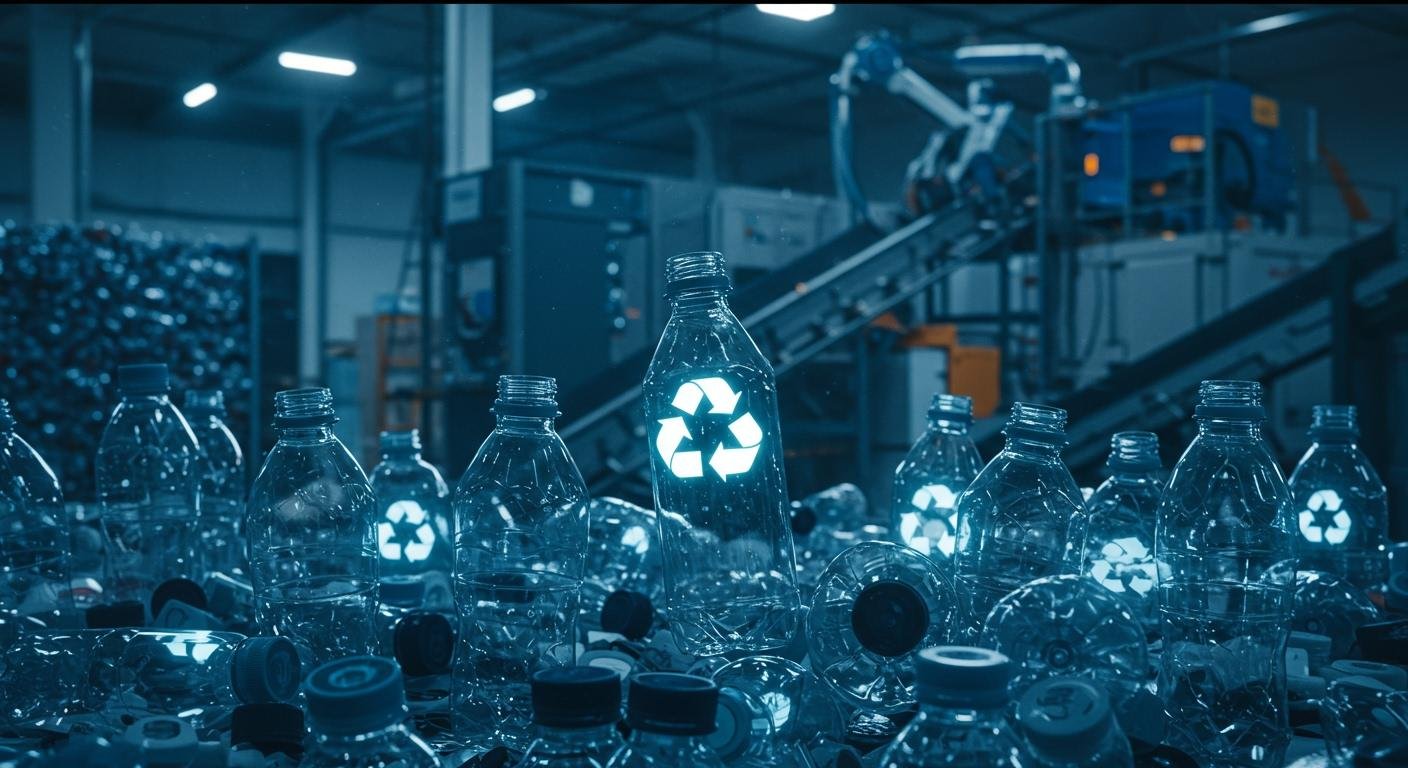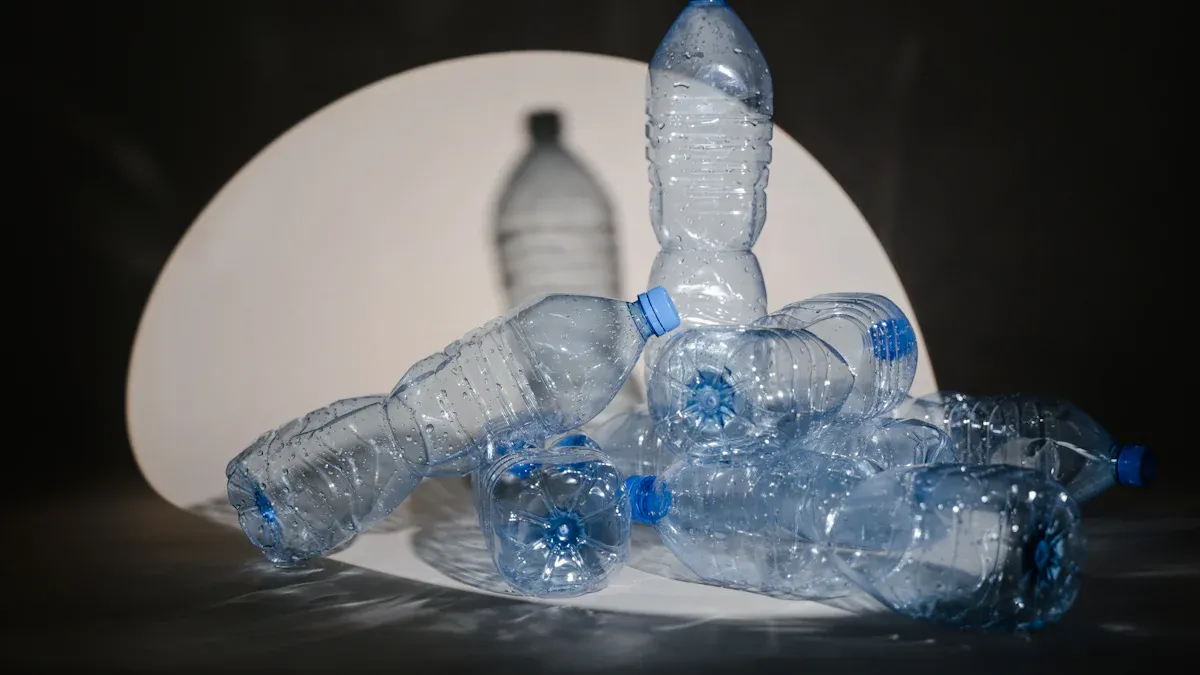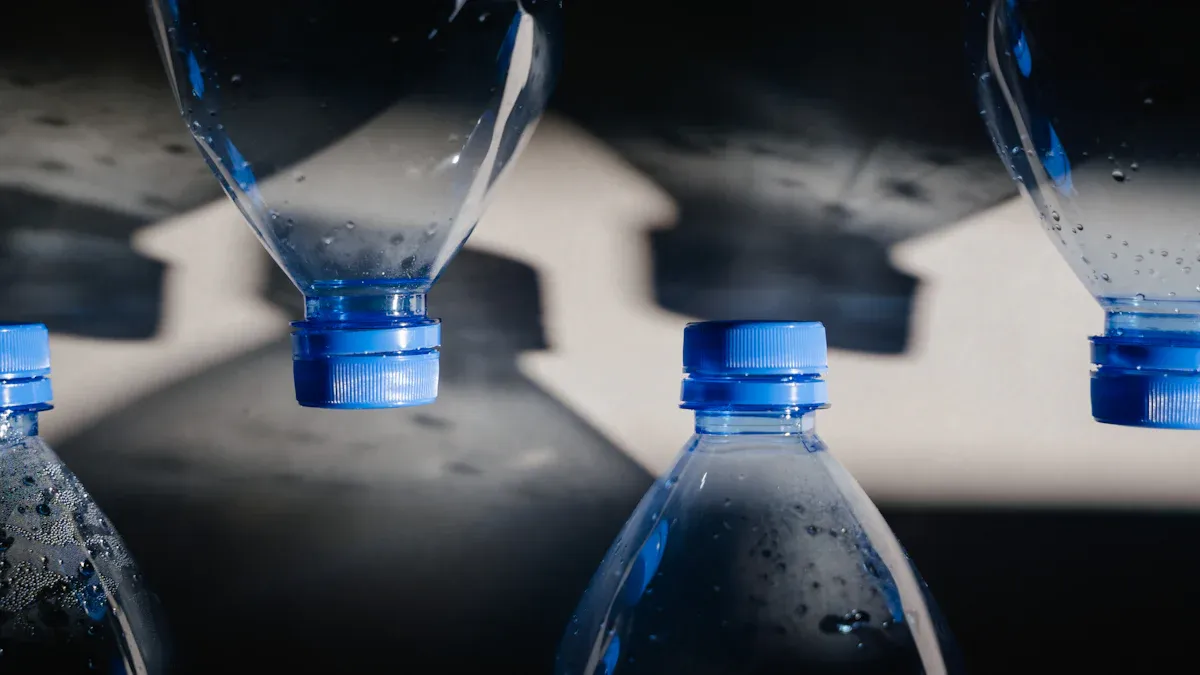Recyclable Bottles and Caps in 2025
Table of Contents

Your common plastic bottles are very recyclable in 2025. Programs widely accept plastic bottles made from PET #1 and HDPE #2. This packaging is highly recyclable. A big question is what to do with the caps.
The 2025 Rule: You should leave the plastic caps ON empty bottles. This simple step helps capture more plastic packaging. It ensures these valuable recyclable bottles and their caps enter the recycling stream together.
A Guide to Recyclable Bottles

You can make a big impact by choosing products in recyclable packaging. Your choices matter to brands and the planet. In fact, your focus on recyclability is a major driver for change.
A 2025 consumer report shows that 77% of US shoppers consider recyclability “extremely important” for sustainable packaging. This sends a clear message about the demand for sustainable choices.
Understanding which materials are best helps you recycle correctly. Here is your guide to the most common recyclable bottles and their packaging.
PET (#1) – Water and Soda Bottles
You will find PET plastic almost everywhere. It is the clear plastic used for water bottles, soda bottles, and many food jars. This material is lightweight, strong, and highly recyclable. Its high recyclability makes it a valuable resource. To prepare these plastic bottles for a new life, you just need to follow a few simple steps.
- Ensure all bottles are completely empty.
- Give the bottles a quick rinse to remove any residue.
- Place them in your designated recycling bin with the cap on.
HDPE (#2) – Milk and Detergent Jugs
HDPE is another common plastic you see daily. This is the cloudy or colored plastic used for milk jugs, detergent bottles, and shampoo bottles. It is a durable and versatile material. Its strength makes it ideal for a wide range of products beyond just bottles. Many other household items are made from this plastic, including:
- Motor oil bottles
- Household cleaner bottles
- Pipes
- Lawn and garden products
Like PET, this plastic is widely accepted in recycling programs. You should empty and rinse these bottles before placing them in your bin.
Glass – Sorting by Color
Glass offers excellent recyclability and is a champion of sustainability. You can recycle glass endlessly without any loss in quality. However, proper sorting is the key to successful glass recycling. Separating glass by color is critical. Your local program may ask you to sort glass into clear, brown, and green containers.
Why is sorting glass so important?
- Each color of glass has a unique chemical makeup. Mixing them contaminates the batch.
- Separation ensures the recycled glass material can be used to make new, high-quality glass containers of the same color.
- Mixed, unsorted glass often becomes a lower-grade material, used for things like road aggregate instead of new bottles.
Modern recycling facilities use advanced sensors to sort glass, but your initial sorting at home makes the process much more efficient. Correctly recycling glass helps conserve raw materials and energy.
Aluminum – A High-Value Recyclable
Aluminum is one of the most valuable materials in your recycling bin. It is used for soda cans, food cans, and some bottles. The global recycling rate for aluminum beverage cans is an impressive 71%, showing a strong commitment to sustainability.
Recycling this material provides enormous environmental benefits. Making a new can from recycled aluminum uses 95% less energy than making one from raw materials. This incredible energy saving makes aluminum a cornerstone of a circular economy. Always recycle your aluminum cans and bottles to help conserve resources and support a more sustainable system. These recyclable bottles are a top choice for eco-conscious consumers.
Solving the Cap Conundrum

You have likely heard conflicting advice about bottle caps over the years. For a long time, the rule was “caps off.” However, the standard has changed. Understanding the new rule is key to recycling correctly in 2025. This change helps capture more valuable plastic and improves the entire recycling system.
Why “Caps On” is the 2025 Rule
You should always screw the caps back onto your empty plastic bottles before recycling them. Major organizations like The Association of Plastic Recyclers (APR) now officially recommend this practice. The reason is simple: loose caps are too small for sorting machinery. They often fall through the cracks and end up in the landfill.
Keeping the cap on the bottle ensures it travels through the sorting process successfully. This simple action has a huge environmental benefit.
- Bottle caps are one of the top 10 items found during beach cleanups.
- Marine animals often mistake these small, colorful plastic pieces for food.
- Ingested caps are a major choking hazard and are among the top five most deadly types of marine debris.
By screwing the cap back on, you prevent it from becoming harmful litter.
So, what changed? Technology. Modern Material Recovery Facilities (MRFs) now use incredible technology to sort our recycling. These advancements make it easy to process bottles with their caps on.
- Advanced Optical Sorters use near-infrared (NIR) lasers and high-speed cameras to identify different types of plastic. They can tell the bottle and cap apart.
- AI-Empowered Robotics work alongside optical sorters to physically pick and separate materials with high accuracy.
- Deep Learning Software allows the system to recognize and sort materials that were previously difficult to identify, ensuring the whole packaging unit is handled correctly.
This technology allows recyclers to recover the plastic from both the bottles and the caps, creating more value. For best results, the APR advises you to crush the air out of your bottles before screwing the cap back on.
Identifying Recyclable Caps (PP #5)
Most plastic bottle caps are made from a different type of plastic than the bottles themselves. While bottles are typically PET #1 or HDPE #2, their caps are usually Polypropylene (PP #5). This is a durable and highly desired material. When you recycle your bottles with the caps on, you are also sending this valuable plastic to be reused.
Recycled PP #5 plastic has a surprisingly versatile second life. It can be transformed into a wide range of new products, reducing the need for new raw materials.
| Category | Examples of Recycled PP #5 Products |
|---|---|
| Household Goods | Food storage containers, kitchenware, brushes, storage racks |
| Automotive Parts | Battery cables, cases, interior components |
| Gardening | Flower pots, garden furniture, watering cans |
| Industrial | Shipping pallets, crates, industrial fibers, pipes |
Non-Recyclable Closures to Discard
While the “caps on” rule applies to most screw-top bottles, some closures are not recyclable and should be thrown away. The main culprits are closures made from multiple materials.
Watch Out for Mixed Materials! Lotion pumps, trigger sprayers, and some complex caps contain different materials combined into one piece of packaging. A lotion pump, for example, has a plastic body, a metal spring, and sometimes a glass ball inside.
Recycling facilities cannot easily separate these fused materials. The metal spring in a plastic pump contaminates the plastic batch, making it unusable. The current recycling infrastructure is not built to handle this complex packaging. Attempting to recycle them creates problems and reduces the quality of the final recyclable material.
Your best action is to remove these complex closures from your bottles and place them in the trash. You can then recycle the empty bottle.
The Future of Sustainable Packaging
The future of packaging is moving away from a “take, make, and discard” model. You are now part of a shift toward a circular economy. This system keeps materials in use for as long as possible. Your choices drive brands to improve the sustainability of their products. This change helps reduce waste and protect our environment.
Eco-Friendly Material Innovations
You will see more eco-friendly materials on shelves. Brands are exploring new options made from plants, like corn (PLA) and even seaweed. These biodegradable materials aim to reduce the reliance on traditional plastic. Many companies have set goals to use more recycled material in their packaging.
| Company | 2025 Recycled Content Goal |
|---|---|
| Coca-Cola | On track to make all packaging globally recyclable. |
| evian | Aims for 50% recycled PET (rPET) use in its bottles. |
However, these new eco-friendly materials can create confusion. Some cannot be recycled with regular plastic and may contaminate the recycling stream. True sustainability for any new material depends on having the right systems to process it.
The Rise of Compostable Packaging
Compostable packaging is designed to break down into natural elements. These biodegradable materials are a great option for eco-friendly packaging. But you must know how to dispose of them correctly. Most compostable packaging needs an industrial composting facility. These facilities use high heat to break the material down quickly. Your home compost pile does not get hot enough.
Important Tip: Never put compostable or biodegradable packaging in your recycling bin. It contaminates the plastic recycling process and lowers the quality of the final recycled material.
The Role of Reusables in Sustainability
Choosing reusable containers is a powerful way to reduce your environmental impact. A reusable bottle’s true benefit depends on its packaging lifecycle. Studies show you need to use a reusable bottle between 10 and 20 times to offset the environmental impact of making it. After that break-even point, every use lowers its overall environmental impact compared to single-use plastic. This makes reusables a very sustainable choice for long-term sustainability and supports the goal of better recyclability for all packaging.
You can improve sustainability with your daily actions. Here is your 3-step plan for better recycling.
- Choose Wisely. Your packaging choices make a difference. Select products in highly recyclable bottles, like PET, HDPE, glass, and aluminum packaging. These recyclable bottles are a sustainable choice.
- Recycle Correctly. Always empty your bottles. Screw the caps back onto the empty bottles before recycling the packaging.
- Reduce First. Prioritize reusable bottles. Using reusable bottles is the most sustainable and eco-friendly action for long-term sustainability and better packaging.
FAQ
Why can’t I recycle all plastics?
Recycling facilities are set up for specific plastic materials. Plastics like PET #1 and HDPE #2 have strong markets. Other types are harder to process or have less value. Your local program accepts the most valuable materials to ensure they can be successfully recycled.
Do I need to wash glass bottles before recycling?
Yes, you should give
glassbottles a quick rinse. This removes residue that can attract pests. Cleanglassimproves the recycling process. It ensures the newglassmaterialis high quality. Your cleanglasshelps create newglassbottles from qualityglass.
What is the difference between biodegradable and compostable?
Biodegradable items break down in nature over time. Compostable items need specific conditions, like an industrial facility, to become soil. You should check local rules for biodegradable packaging disposal. This material often cannot go in your home compost or recycling bin.
Can I recycle broken glass?
You should check with your local recycler. Most programs do not accept broken glass. The small pieces can injure workers and damage machinery. This broken material contaminates other recyclables. It is a different material stream than whole glass containers. Safe glass recycling is key.

Poseidon
Master of Nutritional Epidemiology, University of Copenhagen, Herbal Functional Nutrition Researcher
Focus: The scientific application of natural active ingredients such as Tongo Ali, Horny Goat Weed, and Maca to sexual health and metabolic regulation.
Core Focus:
Men: Use a combination of Tongo Ali (an energizing factor) + Maca (an energy reserve) to improve low energy and fluctuating libido.
Women: Use a combination of Horny Goat Weed (a gentle regulator) + Maca (a nutritional synergist) to alleviate low libido and hormonal imbalances.
Stressed/Middle-Aged Adults: This triple-ingredient synergy supports metabolism, physical strength, and intimacy.
Product Concept:
Based on traditional applications and modern research (e.g., Tongo Ali promotes testosterone-enhancing enzyme activity, and icariin provides gentle regulation), we preserve core active ingredients and eschew conceptual packaging—using natural ingredients to address specific needs.
Simply put: I'm a nutritionist who understands "herbal actives." I use scientifically proven ingredients like Tongo Ali, Epimedium, and Maca to help you make "sexual health" and "nutritional support" a daily routine.
